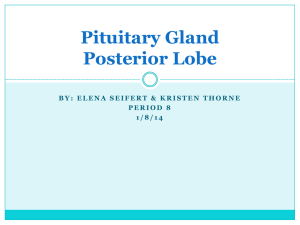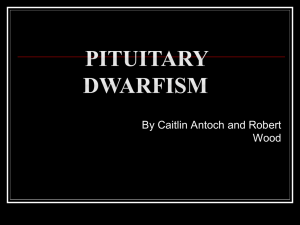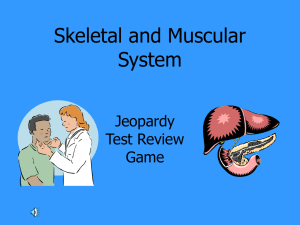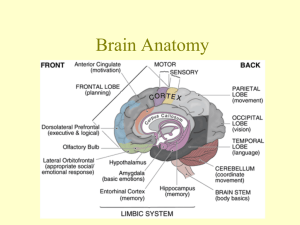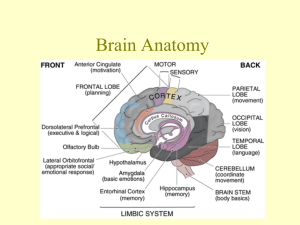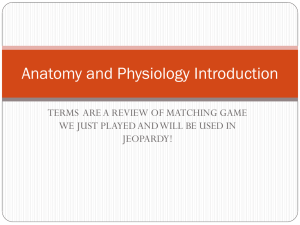Posterior Pituitary & Pineal Glands
advertisement
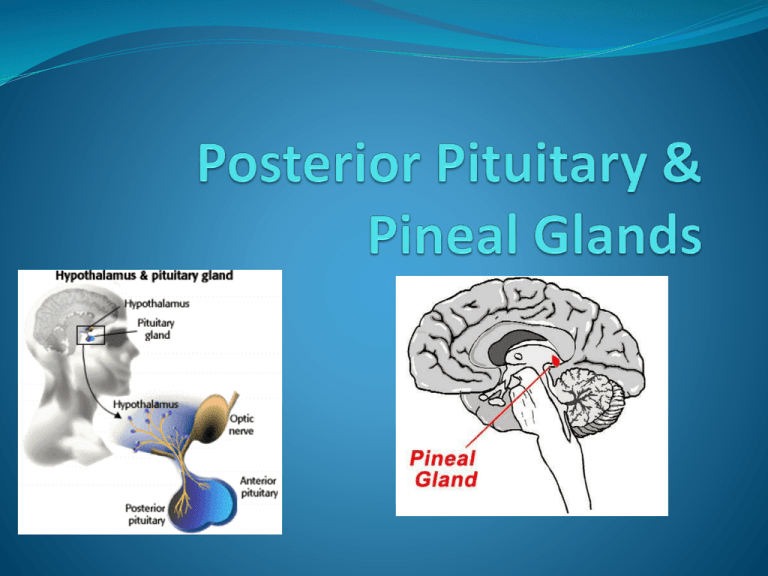
Posterior Pituitary Gland The Pineal Gland Description of Glands: The pituitary The pituitary gland has dimensions of about 12mm by 8mm in an average adult. There are three major divisions in the gland and they are the anterior lobe, the posterior lobe, and the neurophysis. (we will focus on the posterior lobe) Despite its name, the pituitary gland is not actually a gland, but is a large collection of axonal projections from the hypothalamus that end behind the anterior pituitary gland. Description of Glands: The pineal The pineal actually isn’t a gland, but it is a neuroendocrine transducer which means that it converts incoming nerve impulses into outgoing hormones The pineal gland is small weighing slightly more than one gram It is microscopically made of pinealocytes which are supporting cells It releases hormones in response to biotechnical messages from outside the body the information is received through the eyes. Where are the glands Located? The pituitary Gland is in the hyposophyseal fossa of the sphenoid and is connected to the hypothalamus by the infundibulum. The Pineal gland is located deep within the brain between the two cerebral hemispheres, above the third ventricle of the spinal cord Hormones produced The posterior pituitary gland produces two hormones: antidiuretic hormone also known as vasopressin, and Oxytocin The pineal Gland produces only one hormone called Melatonin. Hormones cont’d The pineal gland also contains numerous polypeptides such as vasotocin, GnRH, and TRH and neurotransmitters like somatostatin, noerpinephrine, seretonin and histamine Melatonin is a protein hormone Both Oxytocin and Vasopressing (ADH) are protein hormones consisting of 9 amino acids Target Cells for each hormone Antidiuretic hormone affects the kidneys, and the vascular system. It binds to the cells in the collecting duct of the kidney Oxytocin targets the smooth muscle (myoepithelial) cells in the mammary aveoli, and also the smooth muscles in the uterus when a woman is giving birth. Oxytocin also affects the brain – it is found in the cerebrospinal fluid in high concentrations after a woman has had her baby. Melatonin can penetrate any cell in the body Effects of ADH on Target cells The antidiuretic hormone affects the kidneys by binding to the receptors on cells in the collecting ducts of the kidney and promotes reabsorbtion of water back into the circulation. It stimulates water reabsorbtion by stimulating insertion of aquaporins into the membranes of the kidney tubules The aquaporins transport solute-free water through tubular cells and then back into the blood which causes a decrease in plasma osmolarity and an increase in osmolarity of urine. Effects of Oxytocin on target cells Oxytocin stimulates the milk letdown in the mammary glands because it stimulates the contraction of the myoepithelial cells causing milk o be ejected into the ducts. It also stimulates contractions in a woman when giving birth. Lastly, oxytocin stimulates the establishment of maternal behaviour after the baby is born. Effects of Melatonin on the target cells Melatonin secretion is enhanced when the sympathetic nervous system is stimulated. In children, it acts to keep a child’s body from becoming sexually mature. It appears to play a role in regulating sleeping cycles (higher levels of melatonin are found in young children which accounts for their increased need for sleep) Triggers/Controls for the hormone production The main variable in the controls/triggers of ADH is the plasma osmolarity (concentration of solutes in blood) which is detected by the osmoreceptors (neurons connected to blood vessels) which relay into the hypothalamus If there is a high concentration of solutes, ADH is produced and secreted out of neurons in the bloodstream If the concentration is low, ADH is suppressed because the osmoreceptors are no longer active This allows the body to regulate the amount of water in the body Other variables which affect the triggers or controls of ADH are blood pressure, volume of blood (censored by stretch receptors in the heart, which are not as sensitive of a control as the osmolarity ) Triggers/Controls cont’d Oxytocin is triggered by nervous stimulation of the hypothalamus, or mechanoreceptors in the uterus and vagina during parturition When a baby suckles on its mothers nipple the release of oxytocin is triggered and when there is distension in the cervix. The pineal gland releases melatonin when there is little light entering the eyes, it is secreted from serotonin which is obtained from the amino acid tryptophan There are two melatonin receptors called Me|1a and Me|1b which are found in high densities in the retina, anterior pituitary and hypothalamus Complications due to damage/malfunction of the gland A cause of overproduction of ADH in the posterior pituitary gland is a brain tumour. If there is an overproduction of ADH in the posterior pituitary gland it can lead to water retention serum hypo-osmolarity, hypoatramic, and high urine osmolarity. A cause of ADH underproduction can be cause by head trauma, pituitary tumours, or surgery that damaged the hypothalamus or pituitary If there is an underproduction it may lead to excretions of large volumes of urine (causing dehydration and thirst) and an increased plasma osmolarity. There have been no known issues involving an overproduction of oxytocin however, it has been found that children that do not produce any oxytocin due to a tumour in the pineal gland, reach sexual maturity at a younger age than normal children. Complications continued In mammals, if there is a lesion or non existent pineal gland, it means that the animals cannot detect the proportions of day and night, and therefore they cannot tell what season it is and therefore do not know when to hibernate or when to breed In humans a non functioning pineal gland would cause a person to have less trouble when switching time zones changing job shifts but it may increase their risk of insomnia, and their biological rhythms and patterns may be off.

